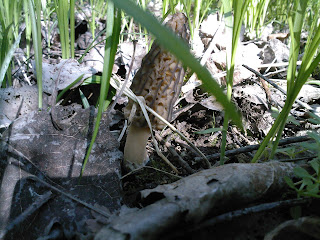From these observations, we can already establish an early prospecting strategy.
The morel likes wetlands, but not too cool and relatively well exposed.
We therefore eliminate the land too heavy and poorly exposed.
To recognize a light or heavy ground , just take a little land and do like gardeners , tighten in your hand.
An heavy soil forms a ball or a compact roll which stays in place, a very light soil or a light soil forms a ball or a roll which disintegrates rather easily.
No need to move with a shovel, the observation of molehills allows you to get an idea of the nature of the soil and to make these tests.
Similarly, the observation of the banks and bottom of a stream provides informations on soil type.
Early in the season, I seek in areas of alluvial valley floors with a relatively light soil, often siliceous, well exposed and relatively sheltered from the cold and drying wind.
If necessary, I can also go a few kilometers towards the plain where the vegetation is often more advanced with milder temperatures.
Later in the season, I seek in higher areas , less well exposed, more windy and dry.
 |
| A nice soil for morel. |
We therefore eliminate the land too heavy and poorly exposed.
To recognize a light or heavy ground , just take a little land and do like gardeners , tighten in your hand.
An heavy soil forms a ball or a compact roll which stays in place, a very light soil or a light soil forms a ball or a roll which disintegrates rather easily.
 |
| Microscopic observations. |
No need to move with a shovel, the observation of molehills allows you to get an idea of the nature of the soil and to make these tests.
Similarly, the observation of the banks and bottom of a stream provides informations on soil type.
 |
| Observation of molehills. |
Early in the season, I seek in areas of alluvial valley floors with a relatively light soil, often siliceous, well exposed and relatively sheltered from the cold and drying wind.
If necessary, I can also go a few kilometers towards the plain where the vegetation is often more advanced with milder temperatures.
Later in the season, I seek in higher areas , less well exposed, more windy and dry.





No comments:
Post a Comment
Thank you for participating !